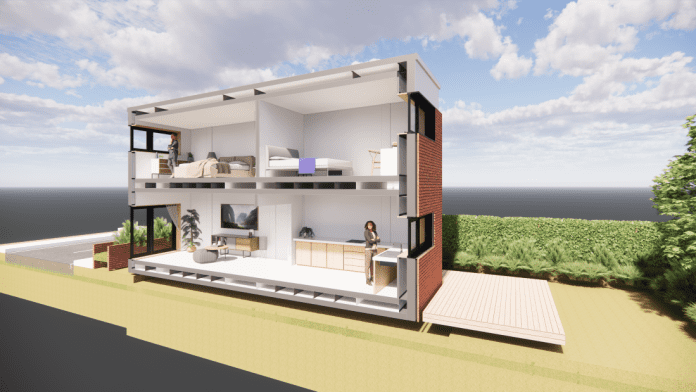Vector Homes has unveiled a prototype rapid-build flatpack housing system built using sustainable and advanced materials at the Energy House 2.0 research facility at the University of Salford. Chief executive Nathan Feddy discusses the mission to cut carbon, cost and complexity in construction
The construction sector is, quite frankly, broken. The process to build houses is incredibly convoluted and arduous, with hundreds of stages to get from concept to delivery.
This complexity leads to prolonged build times and an enormous squeeze on supply. This is contrasted with ever-increasing demand due to population growth – a perfect storm.
This can be seen in government data, with requirements of around 300,000 new houses per year, yet we have been barely achieving 50% of this demand for over a decade. Along with a shortage of land, the result is unsustainable house price growth and an exacerbation of housing inequality.
Not only are we not producing enough houses but the ones we are producing are causing untold environmental and ecological damage. Researchers consistently estimate that around 40% of global greenhouse gas emissions are due to the construction (8%) and operation (32%) of the built environment.
The sector also causes huge ecological damage in terms of deforestation, quarrying and mining. To make matters even worse, DEFRA has estimated that a staggering 59% of the UK’s waste is from the construction sector.
Our flatpack housing solution
Vector Homes will mass manufacture flatpack housing to address these key challenges. On the embodied carbon side, we have designed our system around the principles of the sustainability hierarchy (rethink, reduce, reuse and recycle) and the circular economy.
Rethink: We started the process by asking ourselves: what are the ideal functions of different parts of a house?
This may sound like a trivial question, but it is an important one to ensure integrity on the innovation journey.
Reduce: We used this process to inform our material selection decision-making. This enabled us to reduce the mass of our system to 20% of an equivalent conventional brick house. With our system, a 40sq m bungalow only weighs around 4-5 tonnes. This provides an amazing foundation for reducing embodied carbon.
Reuse: Vector is a great believer in the ancient Greek proverb: “A society grows great when old men plant trees in whose shade they shall never sit.”
We therefore wanted to make a system that was as circular as possible, so we started standardising. We have now developed a super-standardised system on the component level, all the way down to the fixing holes. The assembly of components is done on-site by using a series of bolts.
This enables disassembly rather than demolition. In combination with innovation such as material passports, we can retain greater value in the materials we use.
On top of this, we have been developing fastening techniques that don’t degrade components.
These aspects provide a number of benefits, including a greatly streamlined manufacturing process, which enables us to substantially reduce costs that we can pass on to our customers. Vector’s standardisation creates a simplified building system to enable rapid assembly.
Every component of a Vector home has been designed to weigh less than 25kg. This means that all materials on site can be moved around by a single person, which is within HSE parameters and eliminates the need for heavy lifting.
Because the system is so simple to follow, as developers become more experienced in delivery, the process should get faster and thereby increase productivity.
Recycle: The Vector Homes core team includes a number of nanomaterial scientists, who have been working with industry to incorporate advanced materials into their products. Vector has leveraged this expertise to develop a range of low-embodied carbon materials from recycled waste and natural by-products. The focus has been on upcycling these materials to provide the required properties for use in houses.
All of this only addresses the immediate challenge of embodied carbon. We still have the remaining 32% of operational carbon emissions to consider. We therefore added an extra R, Refit.
Refit: Many companies are working on new technologies to improve the performance of houses. These include new heating, water treatment, energy storage systems and more.
The issue is that with most conventional and contemporary houses, these systems are difficult to incorporate, producing a barrier to entry. We wanted to futureproof our houses with this in mind. We designed our system so that they have an in-built expanded and accessible wall space with service routes running throughout the houses. This means that it is much easier to add on and upgrade the houses throughout the lifecycle to continuously improve efficiency.
Where we are now
We have had the enormous privilege of building our prototype flatpack studio house in the unique Energy House 2.0 at the University of Salford. The £16m facility has phenomenal capability.
It comprises two huge climate-controlled chambers, each of which is capable of hosting two full-sized family homes. This state-of-the-art facility can control temperatures from -20C to 40C, produce wind, rain and snow, and can simulate solar radiation.
This is the first time that construction companies have been able to simulate how their system performs in more than 95% of the world’s weather conditions in a matter of days, rather than years. Alongside the unparalleled expertise of the team of scientists at Energy House 2.0, this is an absolute game-changer in our race to cut carbon in the sector.
We are really putting our house through its paces to enable us to inform continuous improvement in our system, with independently tested data to keep levelling up performance. We are also testing a range of third-party technologies, including air source heat pumps, infrared heating systems and others, so we can make genuine recommendations on which systems to purchase alongside our houses.
Nathan Feddy
Chief executive
Vector Homes














